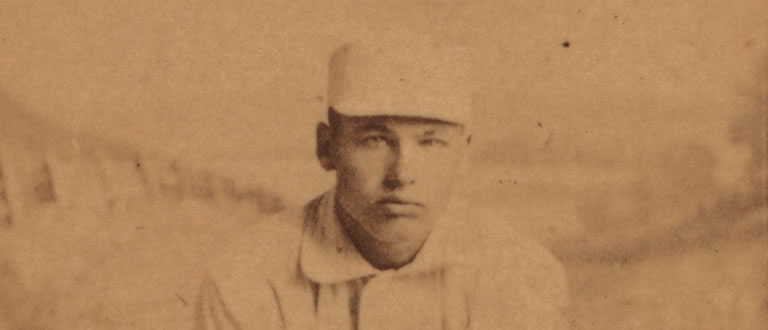Voting Open for the 2013 SABR Nineteenth Century Overlooked Legend
Jun 7, 2013 by Adam Darowski
A few months back, I was asked by Joe Williams (chair of the SABR Nineteenth Century Overlooked Legend Committee) to join the committee. The committee annually selects “a 19th century player, manager, executive or other baseball personality not yet inducted into the National Baseball Hall of Fame in Cooperstown, New York.”
In my role, I helped Joe update the player bios and also added a little “sabermetric slant” to each. While SABR and sabermetrics are often used interchangeably, they are indeed very different things. SABR, the organization, has many members that have still not warmed up the idea of advanced metrics. Part of my job is to make it a bit more accessible for them.
Of the ten finalists on the ballot, seven spent time in “Major League Baseball” (and therefore have stats for me to analyze). Doc Adams and Jim Creighton played before the National Association was established. And while Al Reach did play in the Major Leagues, he did so only briefly and is nominated for his other contributions.
For the remaining seven, here are the “sabermetric slants” I provided:
In addition to leading the National Association in many traditional batting categories, Barnes also led the circuit in Wins Above Replacement (WAR) with 18.9. In the batting component, he was worth 159 runs above average while the next best hitter (Cal McVey) was worth 101 runs above average. Over his entire career, Barnes was worth 59 batting runs above average per 700 plate appearances. For comparison, Babe Ruth was worth 88 and Henry Aaron was worth 44. Defensively, Barnes’ 53 runs above average trail only Bob Ferguson’s 55 in league history.
Caruthers was worth 43.8 WAR in his nine years as a pitcher. While that total alone is impressive, he added another 16.8 WAR as a hitter and position player. This puts him in small group of players who provided sixteen or more WAR both at the plate and on the mound. Caruthers is joined by only Babe Ruth (163.2 WAR at the plate and 20.6 on the mound) and John Montgomery Ward (35.8 WAR at the plate and 28.4 on the mound). This, of course, makes Caruthers’ Hall of Fame case a unique one. While his pitching was certainly impressive, how much should his offense help his case?
Among 19th century shortstops, Glasscock ranks second in both the WAR batting component (behind Hughie Jennings) and fielding component (behind Germany Smith). Glasscock’s 155 batting runs rank behind ten of the twenty-one shortstops currently in the Hall of Fame. His 149 fielding runs rank behind only three (backing up his reputation as the “King of Shortstops”). The only Hall of Fame shortstop with more batting runs and fielding runs than Glasscock is Cal Ripken.
Hines collected 2,133 hits over a 20-year career. That sounds like a solid, but unspectacular career. But he did it in only 1,658 games. He wasn’t missing games because of injury—his teams simply played fewer games. Hines’ durability and production might have made him a 3,000 hit man. In fact, if you project his hit totals over 162 game seasons, he could have gotten 3,972 hits. Of course, this is mere speculation and it is entirely unlikely he would have kept that same pace. But that does give you a general idea of how much playing time his era cost him.
Hoy accumulated 32.6 WAR in his career, which translates to a relatively long career at a moderately above average level. He did pull a unique WAR-related feat, however. He managed a 2+ WAR season in four different major leagues: 4.3 for Washington (National League) in 1888, 4.2 for Chicago (American League) in 1901, 3.4 for St. Louis (American Association) in 1891, and 2.6 for Buffalo (Players League) in 1890. No other player in history has done so in more than three leagues.
Bobby Mathews had a 2.89 ERA and 104 ERA+ in 4,956 innings. Meanwhile, Old Hoss Radbourn had a 2.68 ERA and 116 ERA+ in 4,527 innings. Yet, Mathews is worth 62.2 WAR while Radbourn received credit for 73.5. You would think the difference between the two would be greater. So what gives? Baseball-Reference’s pitching WAR adjusts for not only era and park factors, but also strength of competition and the defense behind the pitcher. No pitcher in history was hurt more by his defense than Mathews. Mathews’ defenses allowed 126 runs more than an average squad. Meanwhile, Radbourn’s defenses helped him more than anyone. They allowed 146 runs fewer than average. This enormous shift closes the gap between their WAR totals considerably. But how much can we trust advanced defensive metrics from the 19th century? It’s a good question. Radbourn’s teams were better than Mathews’, but how much of that was because of the pitching and how much was because of the defense?
While Bob Caruthers has the most combined WAR in the history of the American Association, Mullane holds the record for having the most as a pitcher. Mullane earned 42.0 WAR on the mound and 6.6 offensively for a total of 48.6 (Caruthers had 37.8 as pitcher, 12.3 offensively, and 50.1 total). This honor also has a downside, as he was worth only 19.3 WAR in the National League as age and rule changes took their toll.
Previous winners include Pete Browning (2009), Deacon White (2010), Harry Stovey (2011), and Bill Dahlen (2012). You can vote at the link above. Voting is open this year to all SABR members.
A big thank you to Joe Williams and the rest of the committee for taking me aboard!